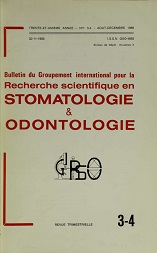Parthenocissus tricuspidata: un modèle végétal d’adhésion biologique
Keywords:
histologie, matériaux, adhesion dentaire, Parthenocissus Tricuspidat, vrille, disque adhésifAbstract
The Parthenocissus Tricuspidata, genus of the Vitaceae family, is a rustic plant with lianas, whose tendrils tips have organelles called adhesive discs that, set near a substrate, adhere to it.
Studies of A.G. ENDRESS, W. THOMSON, S. JUNKER attribue the disc adhesion ability to an adhesive substance secretion instead of a suction mechanism.
Teeth were set beneath the tendrils and in few weeks the adhesion to enamel, dentin and radicular cement was so strong as the usual adhesion to the wall, except with teeth that were set before in fluoride gel, because of the element cytotoxicity.
Then the adhesion place was investigated with microanalysis and S.E.M.
The microanalysis has shown calcium and phosphorus both on enamel and on adhesion place, while silicon, sulphur, chlorine and potassium were only on the adherent vegetable substance.
The S.E.M. analysis was conducted on the enamel surface, after removing of the vegetable, and perpendicularly to the adhesion surface of the vegetable with the enamel, the dentin and the cementum.
Downloads
Published
Issue
Section
License
I hereby certify that the authors of the above manuscript have all:
1. Conceived, planned, and performed the work leading to the report, or interpreted the evidence presented, or both;
2. Written the report or reviewed successive versions and shared in their revisions; and
3. Approved the final version.
Further, I certify that:
1. This work has not been published elsewhere and is not under revision in another journal;
2. Humane procedures have been followed in the treatment of experimental animals (if applicable);
3. Investigations in humans was done in accordance with the ethical standards of the responsible committee on human experimentation or with the Helsinki Declaration (if applicable).
4. This paper has been carefully read by a native English speaker who is familiar with the field of work (this applies to authors who are not fluent in English); and
5. The copyright of the article is transferred from the authors to the Bulletin du Groupement International pour la Recherche Scientifique en Stomatologie et Odontologie upon acceptance of the manuscript.



